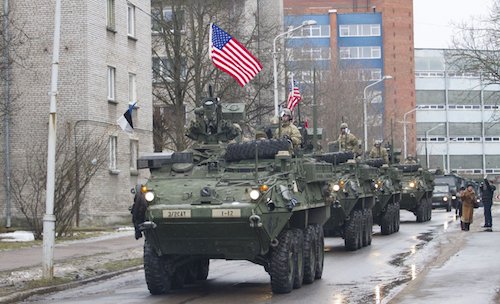Russia’s dramatic intervention in Syria has served to push the conflict in Ukraine (a country that is now partially governed by Star Wars characters) to the back of the world’s collective mind. After all, separatists exchanging fire with government forces and/or far-right “volunteer” battalions every couple of days against a dreary backdrop of rundown Eastern European towns isn’t nearly as exciting as Sukhois dropping bombs on sword-waving desert bandits and so, Ukraine’s crisis has gradually receded into the background.
That said, it’s important to remember that one of the principal reasons for deteriorating relations between Moscow and the West is the conflict in Ukraine.
Indeed, Russian “aggression” in the region has triggered a series of snap drills on NATO’s part, the most amusing of which involved a set of war games centered around the capture of a fictional Ukrainian separatist leader called “Birdman” who lived in a shack in the forest. But all humor aside, NATO has also moved to beef up its capabilities near Russia’s border, as the US prepares to place heavy weapons in Poland and the Pentagon runs simulations to determine who would win a Balkan battle.
Now, with tensions running higher than ever thanks to the escalating situation in the Mid-East, NATO is set to bolster its Eastern flank to guard against what the West imagines is an imminent Russian invasion. Here’s WSJ with more:
NATO countries are discussing increasing the number of troops stationed in members bordering Russia and putting them under formal alliance command, part of a new effort to deter aggression from Moscow, according to diplomats and military officers.
Under one plan, the North Atlantic Treaty Organization would have a battalion in Poland and each of the three Baltic states—roughly 800 to 1,000 soldiers in each unit. A more modest version would have a single NATO battalion in the area.
While that sounds great to Washington’s war hawks, the Germans aren’t entirely sure that casting The Kremlin as the real world equivalent of the Death Star is a particularly sound idea when it comes to effective long-term foreign policy objectives:
While the US and other allies are supportive, German officials in particular have expressed reservations, telling the allies in private discussions that they don’t want to treat Moscow as a permanent enemy or lock it out of Europe, despite the frictions over Ukraine and other provocations.
NATO officials say Berlin is unlikely to back the biggest deployment, but could support the more modest increase.
Of course even a “modest increase” will likely be viewed by Moscow as yet another escalation:
Some allies argue even a small buildup could have the unintended consequence of making a conflict with Russia more likely if mishaps or miscalculations by Mr. Putin accidentally trigger a wider clash.
Yes, “miscalculations by Mr. Putin.” Like the kind of “miscalculations” that can occur when a world leader sees enemy troops massing at his/her borders for no reason whatsoever.
But WSJ wants you to know that this isn’t an offensive move. Much like calls for regular warship patrols near China’s islands in the South Pacific, this is all about “deterrence”:
Senior allied officials say there is a growing agreement that more needs to be done to show Russia that NATO is committed to defend its territory. ‘There is a sense if we are going to have a long-term defense and deterrence strategy we need to discuss what more we need to do beyond our readiness action plan,’ said Alexander Vershbow, the NATO deputy secretary-general.
And because the best defense is everywhere and always a good offense, multiple countries are ready to put troops under NATO command:
US officials have said they are willing put the 150 US soldiers currently in each of the Baltic states and in Poland under NATO command, and are open to rotating in additional troops from the US
The plan would also require other countries that have deployed troops there to agree to a NATO command. The U.K. has about 150 troops there and Germany is deploying up to 200 soldiers.
Senior NATO officials say they believe they will be able to get troop contributions from member nations now, as more come to the conclusion that they face a long-term strategic competition with Russia. ‘The prospects are good that allies will contribute their fair share,’ said a NATO official.
In a sure sign that this is in fact just another example of NATO sabre rattling and, at the risk of employing hyperbole, “warmongering”, US defense officials swear they’re not “picking a fight” (remember, the surest sign that something is probably true is when the official denials start to roll in):
‘We are not picking a fight; we aren’t trying to provoke him,’ said a senior US defense official.
We’ll leave you with the following comments from The Kremlin’s ambassador to NATO Alexander Grushko:
‘NATO military planning generates confrontational approaches to security issues that in our view should belong to the past. The creeping increase in NATO’s military presence on our frontiers [is] testing [our] patience.’
Reprinted with permission from Zero Hedge.


